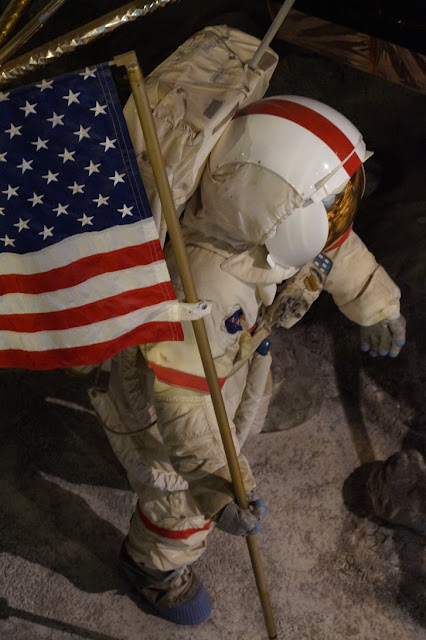Subject: Apollo/Skylab A7L space suit
Location: Museum of science and technology, Chicago, Il, USA 2014.
Comments: The A7L Apollo & Skylab spacesuit is the primary pressure suit worn by NASA astronauts for Project Apollo, the three manned Skylab flights, and the Apollo-Soyuz Test Project between 1968 and the termination of the Apollo program in 1975. The "A7L" designation is used by NASA as the seventh Apollo spacesuit designed and built by ILC Dover (a Playtex division when the suit was designed). The A7L is a design evolution of ILC's initial design A5L and the A6L, which introduced the integrated thermal and micrometeroid cover layer. After the deadly Apollo 1 fire, the suit was upgraded to be fire-resistant and given the designation A7L.The basic design of the A7L suit was a one piece, five-layer "torso-limb" suit with convoluted joints made of synthetic and natural rubber at the shoulders, elbows, wrist, hips, ankle, and knee joints, "link-net" meshing to prevent the suit from ballooning at the joints, and a shoulder "cable block" assembly to allow the shoulder to be extended and retracted by its wearer. Metal rings at the neck and forearms allowed for the connection of the pressure gloves and the famous Apollo "fishbowl helmet" (adopted by NASA as it allowed an unrestricted view, as well as eliminating the need for a visor seal required in the Mercury and Gemini and Apollo Block I spacesuit helmets). A cover layer, which was designed to be fireproof after the deadly Apollo 1 fire, was attached to the pressure garment assembly and was removable for repairs and inspection. All A7L suits featured a vertical zipper that went from the shoulder assembly of the suit down to the crotch for donning and doffing the suit.The two suits for the astronauts that were expected two participate on the lunar excursion have some differences. Between Apollos 7 and 14, the two lunar module astronauts, the Commander (CDR) and Lunar Module pilot (LMP), had Torso Limb Suit Assemblies (TSLA) with six life supportconnections placed in two parallel columns on the chest. The 4 lower connectors passed oxygen, an electrical headset/biomed connector was on the upper right, and a bidirectional cooling water connector was on the upper left.Covering the Torso Limb Suit Assembly was an Integrated Thermal Micrometeoroid Garment (ITMG). This garment protected the suit from abrasion and protected the astronaut from thermal solar radiation and micrometeoroids which could puncture the suit. The garment was made from thirteen layers of material which were (from inside to outside):rubber coated nylon, 5 layers of aluminized Mylar, 4 layers of nonwoven Dacron, 2 layers of aluminized Kapton film/Beta marquisette laminate, and Teflon coated Beta filament cloth.Additionally, the ITMG also used a patch of 'Chromel-R' woven steel (the familiar silver-colored patch seen especially on the suits worn by the Apollo 11 crew) for abrasion protection from the Portable Life Support System (PLSS) backpack. Chromel-R was also used on the uppers of the lunar boots and on the EVA gloves. Finally, patches of Teflon were used for additional abrasion protection on the knees waist and shoulders of the ITMG.Starting with Apollo 13, a red band of Beta cloth was added to the commander's ITMG on each arm and leg, as well as a red stripe on the newly added EVA central visor assembly. The stripes, initially known as "Public Affairs stripes" but quickly renamed "commander's stripes", made it easy to distinguish the two astronauts on the lunar surface and were added by Brian Duff, head of Public Affairs at the Manned Spacecraft Center, to resolve the problem for the media as well as NASA of identifying astronauts in photographs. Lunar crews also wore a three-layer Liquid Cooling and Ventilation Garment (LCG) or "union suit" with plastic tubing which circulated water to cool the astronaut down, minimizing sweating and fogging of the suit helmet. Water was supplied to the LCG from the PLSS backpack, where the circulating water was chilled by an ice sublimator (ref: wikipedia)



























No comments:
Post a Comment
Note: Only a member of this blog may post a comment.